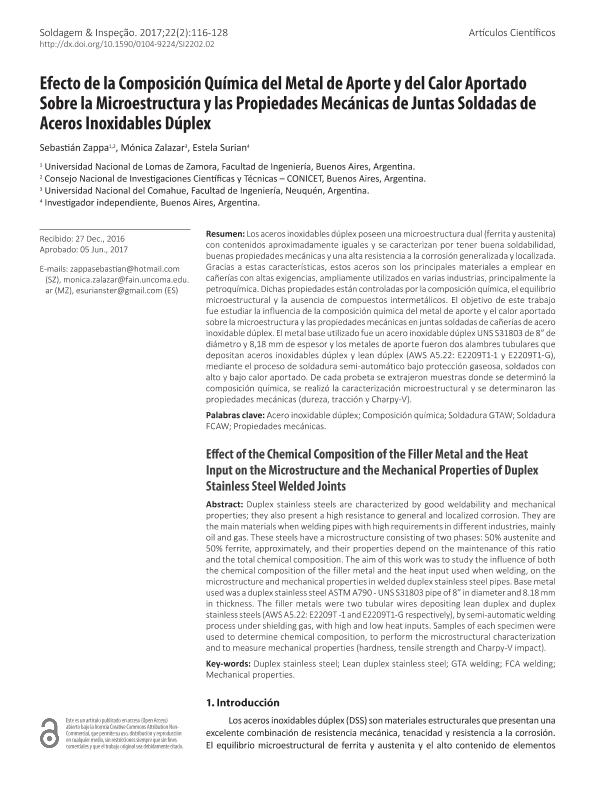Artículo
Los aceros inoxidables dúplex poseen una microestructura dual (ferrita y austenita) con contenidos aproximadamente iguales y se caracterizan por tener buena soldabilidad, buenas propiedades mecánicas y una alta resistencia a la corrosión generalizada y localizada. Gracias a estas características, estos aceros son los principales materiales a emplear en cañerías con altas exigencias, ampliamente utilizados en varias industrias, principalmente la petroquímica. Dichas propiedades están controladas por la composición química, el equilibrio microestructural y la ausencia de compuestos intermetálicos. El objetivo de este trabajo fue estudiar la influencia de la composición química del metal de aporte y el calor aportado sobre la microestructura y las propiedades mecánicas en juntas soldadas de cañerías de acero inoxidable dúplex. El metal base utilizado fue un acero inoxidable dúplex UNS S31803 de 8” de diámetro y 8,18 mm de espesor y los metales de aporte fueron dos alambres tubulares que depositan aceros inoxidables dúplex y lean dúplex (AWS A5.22: E2209T1-1 y E2209T1-G), mediante el proceso de soldadura semi-automático bajo protección gaseosa, soldados con alto y bajo calor aportado. De cada probeta se extrajeron muestras donde se determinó la composición química, se realizó la caracterización microestructural y se determinaron las propiedades mecánicas (dureza, tracción y Charpy-V). Duplex stainless steels are characterized by good weldability and mechanical properties; they also present a high resistance to general and localized corrosion. They are the main materials when welding pipes with high requirements in different industries, mainly oil and gas. These steels have a microstructure consisting of two phases: 50% austenite and 50% ferrite, approximately, and their properties depend on the maintenance of this ratio and the total chemical composition. The aim of this work was to study the influence of both the chemical composition of the filler metal and the heat input used when welding, on the microstructure and mechanical properties in welded duplex stainless steel pipes. Base metal used was a duplex stainless steel ASTM A790 - UNS S31803 pipe of 8” in diameter and 8.18 mm in thickness. The filler metals were two tubular wires depositing lean duplex and duplex stainless steels (AWS A5.22: E2209T -1 and E2209T1-G respectively), by semi-automatic welding process under shielding gas, with high and low heat inputs. Samples of each specimen were used to determine chemical composition, to perform the microstructural characterization and to measure mechanical properties (hardness, tensile strength and Charpy-V impact).
Efecto de la composición química del metal de aporte y del calor aportado sobre la microestructura y las propiedades mecánicas de juntas soldadas de aceros inoxidables dúplex
Título:
Effect of the chemical composition of the filler metal and the heat input on the microstructure and the mechanical properties of duplex stainless steel welded joints
Fecha de publicación:
06/2017
Editorial:
Associação Brasileira de Soldagem
Revista:
Soldagem & Inspeção
ISSN:
1980-6973
e-ISSN:
0104-9224
Idioma:
Español
Tipo de recurso:
Artículo publicado
Clasificación temática:
Resumen
Archivos asociados
Licencia
Identificadores
Colecciones
Articulos(SEDE CENTRAL)
Articulos de SEDE CENTRAL
Articulos de SEDE CENTRAL
Citación
Zappa Maidana, Norberto Sebastián; Zalazar, Monica; Surian, Estela Silvia; Efecto de la composición química del metal de aporte y del calor aportado sobre la microestructura y las propiedades mecánicas de juntas soldadas de aceros inoxidables dúplex; Associação Brasileira de Soldagem; Soldagem & Inspeção; 22; 2; 6-2017; 116-128
Compartir
Altmétricas




